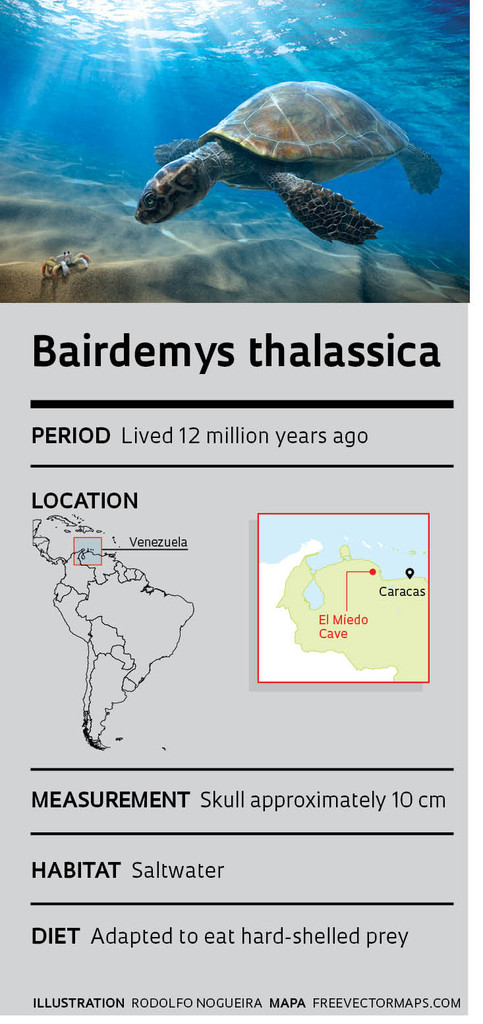 One species from Madagascar and seven from northern South America, all of them freshwater species such as the giant Amazon River turtle (Podocnemis expansa), are the only remaining living forms of the Podocnemididae family of turtles. Most of the known species of this group have disappeared from the Earth. Although there are no present-day members of this family that are adapted to marine environments, a number of fossils suggest that there were lineages of saltwater Podocnemididae in the distant past. A team of Brazilian and Venezuelan paleontologists has described a new extinct turtle species, discovered in northern Venezuela, that provides further evidence in support of that theory. The researchers believe the newly named species Bairdemys thalassica, which lived 12 million years ago, belonged to the “last marine lineage” of Podocnemididae turtles. The new name was chosen to emphasize the turtle’s habitat: in Greek, thalassa means “sea.” The species is described in a paper published in the June 2015 issue of the online scientific journal PeerJ.
One species from Madagascar and seven from northern South America, all of them freshwater species such as the giant Amazon River turtle (Podocnemis expansa), are the only remaining living forms of the Podocnemididae family of turtles. Most of the known species of this group have disappeared from the Earth. Although there are no present-day members of this family that are adapted to marine environments, a number of fossils suggest that there were lineages of saltwater Podocnemididae in the distant past. A team of Brazilian and Venezuelan paleontologists has described a new extinct turtle species, discovered in northern Venezuela, that provides further evidence in support of that theory. The researchers believe the newly named species Bairdemys thalassica, which lived 12 million years ago, belonged to the “last marine lineage” of Podocnemididae turtles. The new name was chosen to emphasize the turtle’s habitat: in Greek, thalassa means “sea.” The species is described in a paper published in the June 2015 issue of the online scientific journal PeerJ.
The B. thalassica fossils consist of a nearly complete skull from the El Miedo Cave located in Cerro Misión, less then 40 kilometers from the Caribbean Sea. Although the fossil has been in the collection of the Paleontology Laboratory of the Venezuelan Institute for Scientific Research in Caracas for several years, it was not studied until mid-2013. “They didn’t have a turtle specialist to work on the material,” says Professor Max Langer, a paleontologist at the University of São Paulo (USP), Ribeirão Preto campus, and co-author of the paper that introduced the species. But Langer had his then-master’s student Gabriel de Souza Ferreira, a biologist and turtle specialist, who is presently working on his PhD. Langer is doing collaborative research with the Venezuelans as part of his work as principal investigator of a thematic project on dinosaur origin and radiation, which led him to undertake joint excavations in that country. The invitation to study the turtle fossil looked like an attractive opportunity, and Ferreira accepted the challenge.
Two types of evidence indicate that B. thalassica lived in a saltwater environment: the characteristics of the fossil site where it was found, and details of the turtle’s anatomy. The cave where it was found is rich in carbonates, which are typically formed in marine environments. In addition to the turtle remains, the walls of the El Miedo Cave contained fossils of cetaceans, fish and seabirds. These clues lend additional support to the idea that the waters of the Caribbean once extended into that area. “The cave was in an area without continental influence,” Ferreira says. “In the Middle Miocene between 16 million and 11.6 million years ago, the entire area was beneath the sea.” The environment where the fossils of the other six species of the extinct genus Bairdemys were found indicates that these turtles exhibited some measure of tolerance to saltwater, and may have lived in estuarine areas of transition between river and ocean environments. “In none of these cases is it possible to say unequivocally—as we are doing with reference to B. thalassica—that these turtles were from an open sea environment,” Langer notes.
The morphology of the Venezuelan fossil—a skull measuring 10 cm, slightly larger than that of the extant species of Podocnemididae—also provides clues to its marine habits. The species featured an expansion of the grinding surfaces of the upper and lower jaws, which means there was a larger area used to process solid food. “We analyzed the geometric measurements of the skull, and we believe this expansion was an adaptation to durophagy,” Ferreira says. “This turtle most likely ate hard-shelled prey, such as mollusks and crustaceans.” Among the living species of saltwater turtles, the loggerhead sea turtle (Caretta caretta), found in oceans throughout the world, also displays an anatomy adapted to durophagy.
The turtle species that now live in the oceans are completely unrelated to living or extinct members of the Podocnemididae family. They descended from separate lineages of turtles that became dominant in the oceans during the Middle Miocene, precisely the period when B. thalassica lived. According to the USP researchers, it is possible that the disappearance of the Podocnemididae turtles from ocean environments is related to the emergence and diversification of other turtles adapted to marine life.
Project
The origin and rise of dinosaurs in Gondwana (late Triassic – early Jurassic) (nº 2014/03825-3); Principal Investigator Max Langer (USP Ribeirão Preto); Grant Mechanism Thematic Project; Investment R$1,587,258.45 (FAPESP).
Scientific article
FERREIRA, G. S. et al. The last marine pelomedusoids (Testudines: Pleurodira): a new species of Bairdemys and the paleoecology of Stereogenyina. PeerJ. June 30, 2015.

